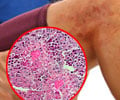
"Acute exacerbations are a major source of morbidity and mortality in asthma," said lead author Maciek Kupczyk, MD, PhD, a researcher at the Karolinska Institutet in Stockholm "In children, the costs of asthma care are three times higher in exacerbators as compared to those patients who did not experience any attacks. Exacerbations are a prominent feature of poorly controlled and severe asthma, and even in patients with mild disease, the rates of severe exacerbations are high."
"Recent ATS/ERS guideline point out that exacerbations constitute the greatest risk to patients, are the major cause of stress and anxiety to patients and their families, and generate the greatest cost to the health care system," continued Dr. Kupczyk. "In our clinical practice, we have recognized a subgroup of asthma patients that experience a higher rate of exacerbations. In contrast to chronic obstructive pulmonary disease (COPD), the phenotype of frequent exacerbators has not been clearly characterized in asthma patients."
The study enrolled 93 patients with severe asthma and 76 patients with mild-to-moderate asthma who were followed for one year. Patients with at least one exacerbation despite high-dose inhaled corticosteroid treatment and specialist care in the year prior to enrollment in the study were considered to have severe asthma.
A total of 122 exacerbations were recorded during follow-up, including 104 that occurred in 52 patients with severe asthma and 18 that occurred in 16 patients with moderate asthma. Frequent exacerbations occurred only in the severe asthma group.
Frequent exacerbators used significantly higher doses of inhaled and oral glucocorticosteroids, had worse asthma control, and had higher C-reactive protein levels and higher sputum eosinophils at baseline as compared with non-frequent exacerbators. A significantly faster decline in FEV1/FVC ratio was also seen in frequent exacerbators.
Advertisement
"Exacerbations are important events in the natural history of asthma that is not well controlled," said Dr. Kupczyk. The implications of these flare-ups include an increased risk of mortality, low health status, decreased quality of life, and extensive utilization of health care resources."
Advertisement
"Appropriate long term management strategies using a personalized medicine approach, coupled with improved compliance, should reduce mortality and morbidity associated with asthma exacerbations," Dr. Kupczyk concluded. "However, further studies are needed to clarify which treatment option is optimal in frequent exacerbators."
###
"Identification Of Risk Factors For Frequent Exacerbations In Severe Asthma" (Session A92, Sunday, May 20, 2:00- 4:30 p.m., Room 2005-2007, Moscone Center; Abstract 31646)
* Please note that numbers in this release may differ slightly from those in the abstract. Many of these investigations are ongoing; the release represents the most up-to-date data available at press time.
Abstract 31646
Identification Of Risk Factors For Frequent Exacerbations In Severe Asthma
Type: Scientific Abstract
Category: 01.10 - Clinical Asthma (AII)
Authors: M. Kupczyk, S. Hague, R. Middelveld, B. Dahlen, S.-E. Dahlen; Karolinska Institutet - Stockholm/SE; On behalf of the BIOAIR Group
Abstract Body
Rationale: Frequent exacerbations are a poor prognostic sign in asthma. There are few studies on exacerbations that have followed patients with repeated objective measures over longer time-periods. In the European multicentre study BIOAIR on severe asthma, we aimed at assessing if certain risk factors could be associated with an exacerbation-prone phenotype.
Methods: 93 patients with severe asthma (SA) and 76 with mild-to-moderate asthma (MA) were followed up for one year with recording of daily symptom and lung function using electronic diaries (Vitalograph®) and extended measurements being done at clinic visits every third month. Severe asthma was defined by at least one exacerbation in the year preceding the start of the study despite use of high doses of inhaled corticosteroids (≥1600 μg of budesonide or equivalent) and specialist care. Risk factors for frequent exacerbations (FE) (defined as either ≥2 or ≥3 events/year) were evaluated in a comprehensive database on patient characteristics.
Results: In total, 122 exacerbations were recorded, including 104 events in 52 SA patients (55.9% of SA cohort) and 18 events in 16 MA (22.2% of MA cohort). The average rate of exacerbations was 1.1 events per patient per year in SA and 0.2 events in MA. Significant decrease in PEF values, FEV1, increase in rescue medication use, day and night symptoms during exacerbations were recorded (p<0.05). All FE were found only in SA, not MA group. Frequent exacerbators used significantly higher doses of inhaled (1700 vs 800 μg) and oral (6.7 vs 1.7 mg) glucocorticosteroids, had worse asthma control (ACQ score 2.3 vs 1.4), lower quality of life (SGRQ score 48.5 vs 33.3), higher CRP level (6.8 vs 4.3 mg/L) and higher sputum eosinophils (25.7 vs 8.2%) at baseline as compared with non-frequent exacerbators. Juniper ACQ score, sputum eosinophils≥2%, smoking history, quality of life, and FEV1≤70% were associated with the development of exacerbations in FE defined as ≥2 events/year (odds ratios OR: 5.06, 4.38, 3.48, 2.48, 2.34, respectively, p<0.05). BMI>25, quality of life, smoking and Juniper ACQ score were risk factors for exacerbations in FE defined as ≥3 events/year (odds ratios OR: 8.07, 6.7, 4.25, 4.14, respectively, p<0.05).
Conclusion: Frequent exacerbators represent a distinct phenotype of the severe asthma group. Identification of factors associated with a higher risk of exacerbations enables us to improve the standards of every day care in this subgroup of patients and to search for involved mechanisms.
Funded by: EU, National funding bodies in the participating BIOAIR centres, The Osher Initiative for Severe Asthma Research at Karolinska Institutet, The Swedish MRC, Heart-Lung Foundation, Strategic Research Foundation, Vinnova (CiDAT), and Stockholm County Council (ALF).
Source-Newswise













